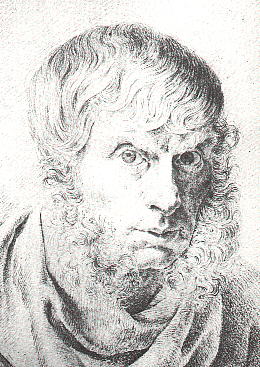Beskrivning
At the heart of German Romanticism, Caspar David Friedrich's 1810 Self-Portrait stands as a testament to the search for the self and the connection with the landscape. Friedrich, known for his ability to evoke a deep sense of spirituality through nature, here presents an introspection that goes beyond mere physical representation. The work is a clear reflection of the aesthetic and philosophical sensibility of his time, in a context where the individual begins to be a central figure in the search for meaning.
The composition is notable for its use of space and the way Friedrich presents himself in a natural setting that seems to be both a reflection of his soul and a stage in which he explores his identity. The self-portrait is not simply an image of the artist; it is, at its core, a dialogue between the human being and the world around him. Friedrich is depicted in a contemplative pose, in his characteristic clothing of the period, which lends an aura of dignity and reflection. His gaze, serious and absent, seems to be directed towards an unattainable destination, thus encapsulating the romantic longing for the sublime.
The use of colour is essential to the interpretation of the work. Friedrich's palette is composed of dark, earthy tones, combined with lighter shades that evoke an atmosphere of mystery. The silent, hazy background merges with the shapes of the landscape, establishing an emotional connection between the artist and his surroundings. This use of light and shadow not only accentuates the figure of Friedrich himself, but also invites the viewer to participate in his contemplation, thus becoming an accomplice to his experience.
The natural elements that surround him, though subtle in their depiction, are equally revealing. The trees in the background provide a sense of depth and at the same time evoke the idea of the eternal, of what remains intact amidst the transience of human life. This relationship with nature is a recurring theme in Friedrich’s work and aligns with his search for transcendent beauty and the sublime. Through his own image, the artist seems to question the role of the human being in the vast landscape of the world, an echo of the existential and philosophical conflicts that characterize the Romantic era.
It is important to note that this painting, framed in the context of Romanticism, is no exception to the rule that characterizes many of Friedrich's creations, where the individual is often depicted in solitude, in deep reflection before a vast natural setting. His work invites contemplation not only of the external, but also of the internal. The duality between the subject and his environment is materialized, revealing a deeper understanding of the human condition.
This self-portrait is less a display of technical skill and more a measure of the internal journey the artist has undertaken. Through this work, Caspar David Friedrich reminds us of the importance of the landscape in our understanding of the self, a path that so many artists have explored, but which in his work becomes a unique discourse that resonates in the psyche of each viewer. In this way, “Self-Portrait” stands not only as a milestone in the painter’s career, but as an essential component in the understanding of Romantic art, where the search for personal meaning is intertwined with an unbreakable connection to the majesty of nature.
KUADROS ©, a famous painting on your wall.
Hand-made oil painting reproductions, with the quality of professional artists and the distinctive seal of KUADROS ©.
Painting reproduction service with satisfaction guarantee. If you are not completely satisfied with the replica of your painting, we will refund 100% of your money.

